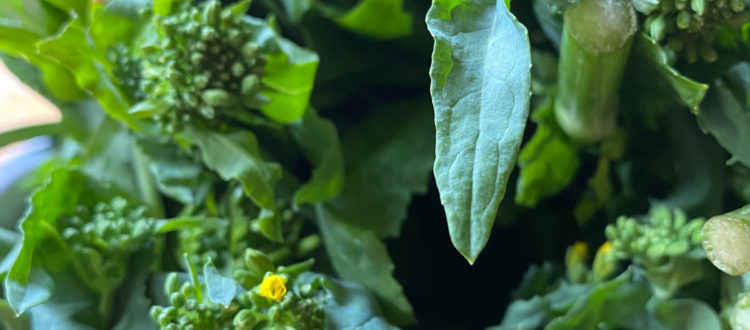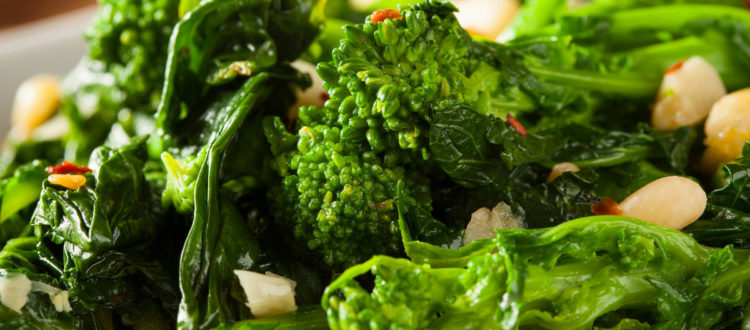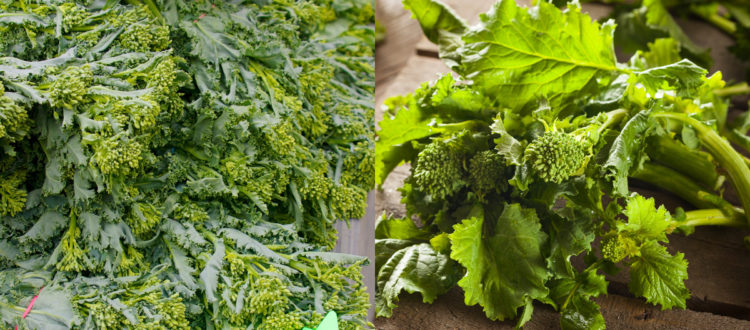Late winter is a wonderful time to experiment with the variety of greens at market, and one of those that makes their appearance this time of year is raab. With their slender stalks and leafy greens topped with small broccoli-like florets, the presence of raab at market signals that spring is near.
If you have not yet experienced raab, you are in for a peppery and often nutty flavor punch – something we all need, especially after months of winter squash, root vegetables, and chard reminding us it’s still winter.
Not sure what raab is? How to pick the best bunch? What do with it? Let us help guide you through the flavorful world of raab.
WHAT IS RAAB?

Raab, pronounced “rob”, are the flowering stems of the large family of Brassicaceae, whose members include kale, turnips, Brussels sprouts and mustards, to name a few. Overwintered brassicas develop these blossoming structures to produce seeds typically in the late winter and early spring.
Raab is usually tender and sweet-tasting due to their sugar production that serves as antifreeze during the winter. Depending on the type of brassica and the maturity of the raab, flavors can vary from sharp, spicy, and earthy to very nutty!
Originating in the Mediterranean and China, raab is cultivated internationally. It is known by many different names throughout the world such as rappi, rappone, choi sum, friarelli, taitcat, broccoli rape and Italian turnip. Even though it may look like broccoli or broccolini, raab is botanically closer to turnips. In fact, the word “raab” is derived from the Italian word “rapa” meaning turnip.
Raab is available at the farmers market as early as February through April. Unlike the grocery store, where broccoli rapini is the closest thing to raab that is available, farmers in the Pacific Northwest showcase many kinds of raab. Kale, turnip, cabbage, tatsoi, bok choy, collard, mustard and mizuna raabs are all found at market in the late winter and early spring.
Raab is an excellent source of vitamins A, C, & K, magnesium, calcium, copper, manganese, vitamin B6, and potassium. High in fiber too!
DIFFERENCE BETWEEN RAAB, RABE, AND RAPINI
Raab and ‘rabe’ are interchangeable terms, and describe the flowering stalks of kale, collards, and turnips that appear in late winter and early spring.
Rapini, also known as broccoli rabe, is its own plant and not a result of an overwintered brassica. It may resemble broccolini or Chinese broccoli but is not a broccoli derivative. Its flavor profile is typically bitter and peppery like mustard greens.
WHAT TO LOOK FOR WHEN BUYING
Choose raab with firm yet slightly flexible stems and bright green florets and leaves with small yellow florets just beginning to open.
Avoid bunches with thick stems (they tend to be tough and stringy), fully blooming florets, and leaves that are wilted, yellowing, or have dark green patches of slime.
HOW TO STORE RAAB
Raab is highly perishable.
Keep it in a plastic bag in your fridge and use it within two or three days of purchase for optimal freshness and flavor. The raab can get increasingly bitter and mushy, and the broccoli-like heads may turn yellow the longer it is kept.
HOW TO PREPARE AND COOK RAAB

All the leaves, buds, and stems are edible – so trim the ends and any wilted parts and get to cooking!
- Raab holds up deliciously when it’s lightly steamed or blanched, sauteed, roasted, grilled, or pickled. Try it raw in a salad or feature it on a fresh vegetable platter.
- Classic Italian partners include garlic, red pepper flakes, anchovies, tangy black olives, sausage, sharp cheeses, and fruity olive oil. You can never go wrong with finishing the dish with citrus zest and juice.
- For an Asian flavor profile, use garlic, red pepper flakes, and ginger, with soy sauce and sesame oil or oyster sauce.
- Ask the farmer what their favorite way is to prepare raab. They always have excellent advice and recipes to share.
You can find raab at the farm vendors in the late winter, early spring at PSU Farmers Market, open year round on Saturdays, 9 am – 2 pm.
We hope you take advantage of this flavorful seasonal favorite before it’s gone!

